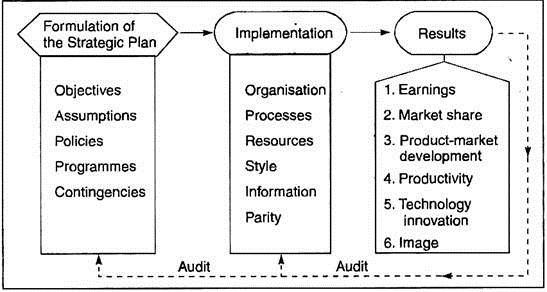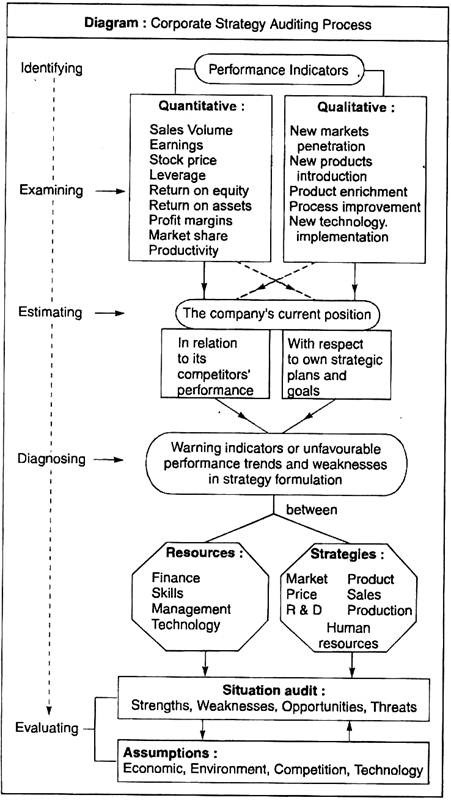In this article we will discuss about:- 1. Concept of Corporate Strategy Audit 2. Outline of Corporate Strategy Auditing Process 3. When to Conduct Strategy Audit 4. Reasons for Organising Strategy Audit Periodically.
Concept of Corporate Strategy Audit:
The core of strategy audit, for any corporate entity, lies on two important questions:
(i) How well a strategy is working, and
(ii) How can this evaluated?
For this, a periodic review and evaluation of the fundamental characteristics of a strategy are necessary.
Any strategy has four characteristics:
1. Strategic decisions determine what a company as a whole seeks to achieve.
2. Whether or not a particular strategy has succeeded.
3. A strategy, being perspective in orientation and dependent on assumptions about the external environment, is inherently uncertain and subject to change (due to environmental shifts).
4. A strategy is ‘typically not a neat, integrated package produced all at once’; rather it tends to be a pattern of objectives, goals, policies and resource-allocation decisions.
Corporate strategy audit, in this sense, is a periodic check-up, that makes an objective appraisal of the integrity of strategic decisions and how well the organisation, its people, and its processes ‘support and reinforce the decisions’.
Again, there are three principal components in a strategic system of management: Formulation, Implementation, and Results. A strategy audit focuses on the key elements of these components as well as on the interrelationships among the elements.
A strategic system follows the pattern like: Formulation → Implementation → Results, but auditing this process starts from the results (i.e. the performance data), ‘A strategy audit goes through the strategy formulation stage in reverse, identifying and tracing the various elements of performance back to their underpinnings in the analysis that produced the plan’.
In so doing, the strategy audit addresses the following key questions:
(i) Is the strategy practical? Any evidence by work?
(ii) Are the corporate objectives and goals, policies, and major programmes clearly articulated and internally consistent?
(iii) Are the business environment assumptions valid?
(iv) Does the strategy continue to be appropriate?
Schematically, the strategy audit appears like:
Since the overall corporate strategy is composed of several other strategies, such as marketing strategy, financial strategy, distribution strategy, pricing policy and strategy, etc., each strategy draws its support from the operations within such strategy.
Thus, corporate strategy audit focuses its direction and analysis to each functional strategy and associated operations.
Outline of Corporate Strategy Auditing Process:
When to Conduct Strategy Audit:
The strategy audit should be conducted under the following circumstances (that means, when any of the following factors are typically warranted):
1. When performance data indicate that the strategy
a. Is not working,
b. Is producing unexpected results, and/or
c. Is producing negative side effects.
2. When activities are not performed as planned.
3. When the management and its people seem to be spending time inconsistently with priorities identified in the strategic plan.
4. When in-congruency is noticed in the interrelatedness of the attainments among the major functions (such as, markets, products, pricing, etc.).
5. When there occurs a change or shift in the external environment; for example, a new competitor has entered the market or the competition announces a technology breakthrough.
Reasons for Organising Strategy Audit Periodically:
A Strategy audit should be organised periodically for the following reasons:
(i) ‘A strategy often takes years to unfold’. Whether a particular strategy was successful or not can be known by passage of time. With the time passing on, considerable resources will be spent, and opportunities to adopt alternative courses of action will be lost. A corporate sector can ill-afford the test of time as the only means to ascertain the viability or otherwise of a strategy. A systematic review of a firm’s strategy and its ability to carry it forward can alert management to problems and to opportunities.
(ii) ‘A strategy is prospective in orientation and rests heavily on assumptions about the external environment’. It is, by its very nature, uncertain and subject to change. A periodic check-up will help ensure that, ‘the plan remains in concert with reality’.
(iii) ‘A strategy is typically not a neat, integrated package produced all at once’. It tends to be a pattern of a series of decisions. It is the integrity of strategic decisions and how well or poorly the organisation, its people, and its processes support and reinforce the decisions. ‘A strategy audit is a vehicle for carrying out such an appraisal’.
(iv) A strategy that was successful in the past can be fine-tuned.
(v) The success of a strategy depends on—how well it is put together (i.e., formulation) and how well it is executed (i.e., implementation). Its evaluation contributes to the relative effectiveness of the factors involved.
(vi) A strategy audit ensures that ‘a strategy which has satisfactorily worked in the past continues to remain in tune with subtle internal or external changes that may have occurred’.

